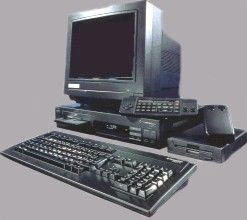 |
 |
 |
 |


In 1990 Commodore launched a machine as ground-breaking as the original Amiga, the CDTV. It was basically an A500 in a black video-style case without the keyboard or disk drive and a CD-ROM drive “stuck on”. But this was not made it special- it was the approach that Commodore took to selling the machine that set it apart from the Amiga. Rather than a computer it was sold as a consumer device in order to compete with the Philip’s CDi. It was criticised by the Amiga fraternity for the lack of expandibility or support from third parties. Until recently it was impossible to upgrade the machine beyond version 1.3 of the OS. It is possible to turn the console into a fully fledged computer by adding a keyboard and disk drive.
The CDTV was hailed as the next computer evolution, moving the machine from the bedroom into the living room.
The only competition was the Phillips CD-i; Even Commodore could have influenced the development of the CD market to favour their machine, right? However, the CD market was still an unknown that had different requirements to the standard Amiga. To investigate this further, Commodore hired a study group to research the area and make recommendations. This resulted in the decision to distance the CDTV from the computer, promoting it as the next generation VCR. Commodore insisted that retailers did not physically place it near to other computers. This led to mass confusion, computer people did not buy it because “it wasn’t a computer”, while non-computer people said it was “too much like a computer.” It only sold in small numbers but did introduce the Amiga to the advantages of CD as a storage method.
CDTV Emulation
Soon after the CDTV’s release, Commodore launched the A570 CD-ROM drive for the A500. This provided limited compatibility with CDTV software.

CPU: 68000 at 7.14 Mhz
FPU: None
Video: ECS (4096 colors)
Kickstart: 1.3 (+ additional CD support).
ROM size: 192 Kb
Memory: 512k (later expanded to 1Mb Chip RAM)
Custom Chips:
Denise – 8373 SuperDenise
Paula
Agnus
Gary
Drives:
Internal Single speed CDROM
Slots:
1 – Credit card type (to save games scores)
1 – Video
1 – DMA extension
Ports:
Mouse & Infrared Joystick
Parallel
Serial
15Khz RGB video
External Floppy
Stereo RCA Audio jacks (16 bit)
Colour composite Video output
MIDI In/Out
Headphone Jack


